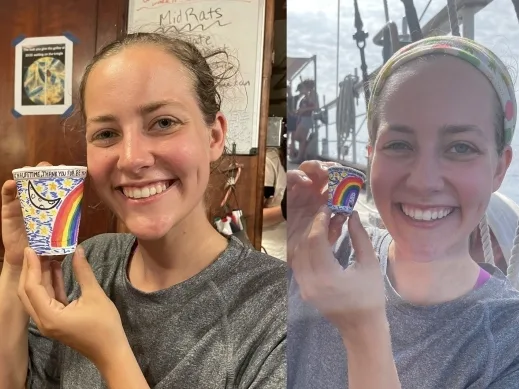Programs Blog
2500 Meters below the Sea

Author: Nicholas Romano, University of San Diego
Talia with her cup, both before and after it either shrank, or she just grew. Unclear which.
Ship’s Log
Position
19° 26.2’ N X 155° 03.3’ W
Taffrail Log
3687 nautical miles
Sail plan / Weather
Motor Sailing under the Main Stays’l; Winds: Light and Variable
For the duration of our cruise we have performed science deployments twice a day, every day. They have become a staple of our routine, stopping the boat around 0900 and then again at 2100, before beginning our deployment with the Hydrocast at 0930 and 2130. The rest of each watch is normally taken up by the rest of the deployment, while the watch following takes care of the sample processing. However, now that we have arrived in Hawaii these routine deployments have come to an end. This morning we dropped our final deployment of the trip, the styrocast. Our normal hydrocast deployments go to a depth of 600 meters, but the styrocast will go much deeper, to 2500 meters. The styrocast got its name from the cargo it carries to depth: Styrofoam cups!
For the past few days the other students and crew have been decorating Styrofoam cups with colorful sharpies in anticipation of this celebratory final deployment. The decorations have been very impressive, with lots of color and incredibly intricate designs. This morning we did a final collection of the cups and at our usual 0930 sent them on their way down. The cups were accompanied with a stand-alone CTD, as well as a pair of Rachel’s Crocs as an added little experiment. It took about 3 hours all told to send the cups down to 2500 meters and back up to the boat. Just like that, our final science deployment of the trip was complete. However, we will always have a memento from it now, in the form of our tiny Styrofoam cups. Rachel’s Crocs seemed to survive pretty well, a little squished but roughly the same size.
On another note, it has been pretty exciting to be in sight of land, but it is still strangely shocking every time I look to starboard and see something other than ocean there. We went about 28 days without seeing land, which makes the sight of it now even more incredible. Last night shortly after the sun we were graced with the incredible sight of the red glow from lava on the steam above it. In truth it was little more than a soft red light in the distance, but the thought of its source was really cool, and something that many of us had never seen before. We are working our way around the coast of the Big Island at the moment, planning on anchoring up later today before jumping across the channel to Maui.
The hope is that given the time of year we should see a decent number of humpback whales around Maui before continuing on to Oahu and Honolulu. As the days remaining on board dwindle, everybody is keen on enjoying every moment, as it very well may be the last time they get to that. One of the things that everybody wants one more turn at is being lookout on night and dawn watch,even if they are not on the deck rotation. Standing alone on the bow of the boat for an hour, staring out at the dark sea underneath a blanket of starsis one of the memories I will always love from the boat.
To my family, I am looking forward to getting home on Christmas Eve! It hasbeen fun thinking about what the tree will look like this year. Hopefully you have saved a few Christmas cookies for me…
Nicholas Romano, University of San Diego
Contact: Douglas Karlson, Director of Communications, 508-444-1918 | [email protected]
Recent Posts from the Ships
- SEA Writer 2022, Magazines From the Summer SEA Quest Students
- PIPA Alumni Reconnect with Children of Kanton
- Woods Hole Welcomes Incoming Class of PEP Students
- Muhlenberg Student Finds Perfect Study Abroad Experience with SEA Semester
- SEA Student Describes Pacific Exploration for University of Denver News
Programs
- Gap Year
- Ocean Exploration
- High School
- Science at SEA
- SEA Expedition
- SEAScape
- Pre-College
- Proctor Ocean Classroom
- Protecting the Phoenix Islands
- Sargassum Ecosystem
- SPICE
- Stanford@SEA
- Undergraduate
- Climate and Society
- Climate Change and Coastal Resilience
- Coral Reef Conservation
- Marine Biodiversity and Conservation
- MBL
- Ocean Exploration: Plastics
- Ocean Policy: Marine Protected Areas
- Oceans and Climate
- Pacific Reef Expedition
- S-299 Summer Session
- The Global Ocean: Hawai'i
- The Global Ocean: New Zealand